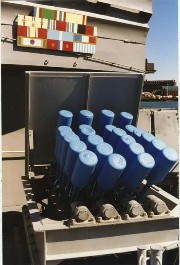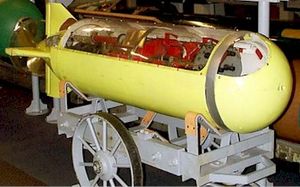
A modern torpedo is an underwater ranged weapon launched above or below the water surface, self-propelled towards a target, and with an explosive warhead designed to detonate either on contact with or in proximity to the target. Historically, such a device was called an automotive, automobile, locomotive, or fish torpedo; colloquially a fish. The term torpedo originally applied to a variety of devices, most of which would today be called mines. From about 1900, torpedo has been used strictly to designate a self-propelled underwater explosive device.

U-boats were naval submarines operated by Germany, particularly in the First and Second World Wars. The term is an anglicised version of the German word U-Boot, a shortening of Unterseeboot, though the German term refers to any submarine. Austro-Hungarian Navy submarines were also known as U-boats.

USS Card was an American Bogue-class escort carrier that saw service in World War II. She was named for Card Sound, a continuation of Biscayne Bay, south of Miami, Florida. She was the flagship of Task Group 21.14 a hunter-killer group formed to destroy German submarines in the North Atlantic.

An anti-submarine weapon (ASW) is any one of a number of devices that are intended to act against a submarine and its crew, to destroy (sink) the vessel or reduce its capability as a weapon of war. In its simplest sense, an anti-submarine weapon is usually a projectile, missile or bomb that is optimized to destroy submarines.
The G7e torpedo was the standard electric torpedo used by the German Kriegsmarine submarines in World War II. It came in 20 different versions, with the initial model G7e(TII) in service at the outbreak of the war. Due to several problems, leading to the German "Torpedokrise" which lasted until the end of 1941, the improved G7e(TIII) took over as the standard electric torpedo used by German U-boats for the rest of the war. G7e torpedoes measured 533.4 mm (21.00 in) in diameter and about 7.2 m (24 ft) in length. Depending on the type, the warhead contained a main charge of 250–280 kg (550–620 lb) of Schießwolle 36, a mixture of dipicrylamine and TNT. All were powered by 60–72 kW (80–100 hp) electric motors and lead-acid batteries which required onboard maintenance to maintain their functionality.

An acoustic torpedo is a torpedo that aims itself by listening for characteristic sounds of its target or by searching for it using sonar. Acoustic torpedoes are usually designed for medium-range use, and often fired from a submarine.
The G7es (T5) "Zaunkönig" ("wren") was a passive acoustic torpedo employed by German U-boats during World War II. It was called the GNAT by the British.

Anti-submarine warfare is a branch of underwater warfare that uses surface warships, aircraft, submarines, or other platforms, to find, track, and deter, damage, or destroy enemy submarines. Such operations are typically carried out to protect friendly shipping and coastal facilities from submarine attacks and to overcome blockades.

The Mark 37 torpedo is a torpedo with electrical propulsion, developed for the US Navy after World War II. It entered service with the US Navy in the early 1950s, with over 3,300 produced. It was phased out of service with the US Navy during the 1970s, and the stockpiles were sold to foreign navies.

German submarine U-515 was a Type IXC U-boat of Nazi Germany's Kriegsmarine built for service during World War II. She was commissioned on 21 February 1942 and sunk on 9 April 1944. U-515 completed seven operational patrols and sank 23 ships, badly damaged two ships which later sank, and damaged two additional ships.
German submarine U-73 was a Type VIIB U-boat of Nazi Germany's Kriegsmarine during World War II. She was laid down by Vegesacker Werft, Germany as yard number 1 on 5 November 1939, launched on 27 July 1940 and commissioned on 30 September of the same year under Kapitänleutnant (Kptlt.) Helmut Rosenbaum.
German submarine U-402 was a Type VIIC U-boat built for Nazi Germany's Kriegsmarine for service during World War II.

German submarine U-117 was a Type XB minelaying U-boat of Nazi Germany's Kriegsmarine during World War II.
HX 237 was a North Atlantic convoy of the HX series which ran during the Battle of the Atlantic in World War II. It was one of several convoy battles that occurred during the crisis month of May 1943.
German submarine U-603 was a Type VIIC U-boat built for Nazi Germany's Kriegsmarine for service during World War II. She was laid down on 27 February 1941 by Blohm & Voss, Hamburg as yard number 579, launched on 16 November 1941 and commissioned on 2 January 1942 under Kapitänleutnant Kurt Kölzer.
German submarine U-456 was a Type VIIC U-boat built for Nazi Germany's Kriegsmarine for service during World War II. She was laid down on 3 September 1940 by Deutsche Werke in Kiel as yard number 287, launched on 21 June 1941 and commissioned on 18 September 1941 under Kapitänleutnant Max-Martin Teichert.
German submarine U-373 was a Type VIIC U-boat of Nazi Germany's Kriegsmarine during World War II.
German submarine U-378 was a Type VIIC U-boat of Nazi Germany's Kriegsmarine during World War II.
German submarine U-422 was a Type VIIC U-boat of Nazi Germany's Kriegsmarine during World War II.
German submarine U-467 was a Type VIIC U-boat of Nazi Germany's Kriegsmarine during World War II.










